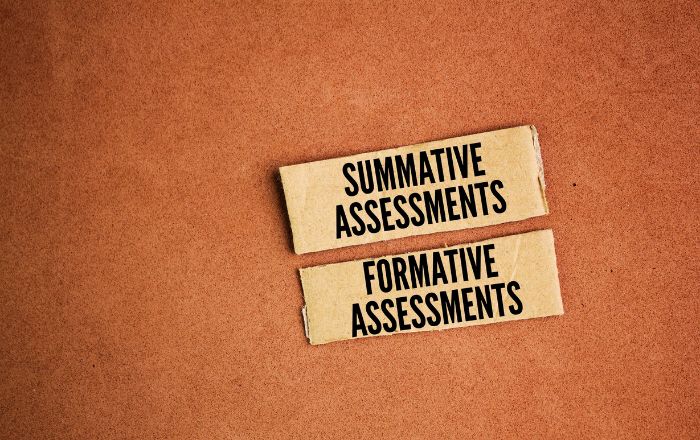Apr 25 2025
Formative vs. Summative Assessments: Which Works Best for Student Success?
Director Product Development

Apr 25 2025
Director Product Development

Assessment has always been the heartbeat of education. But in today’s fast-paced, digitally driven learning environments, the traditional ways of measuring student success are no longer enough. Students don’t just need to pass; they need to engage, grow, and build lasting understanding. And that means the way we assess students must evolve, too.
For educational publishers, this shift brings both opportunity and challenge. How do you create student assessments that transcend simply right or wrong answers? That adapts to each learner’s journey, aligns with evolving standards, and provides value to both teachers and students?
This is where the conversation around formative vs summative assessments becomes especially important.
Both serve distinct purposes, but which is more effective? Is one better suited for student success in a digital-first world? And most importantly, how can publishers build scalable, accessible, and meaningful digital assessment tools for publishers without burning out their content teams or falling behind competitors?
The answers may surprise you. And the tools to solve these challenges may already be within your reach.
Let’s begin by understanding what each type of assessment entails.
Formative Assessments
Formative assessments are conducted during the learning process. Their primary purpose is to check for understanding, identify gaps, and provide timely feedback that can shape future instruction. These are often low-stakes and frequent.
Examples include:
Formative assessments are diagnostic tools. They don’t just measure, they guide.
Summative Assessments
On the other hand, summative assessments are typically conducted at the end of an instructional period. These are high-stakes evaluations used to determine if learning objectives have been met.
Examples include:
Summative assessments measure performance against benchmarks. They capture the cumulative learning journey in a snapshot.
For educational publishers, the difference isn’t just academic, it has real business implications.
To stay relevant in a fast-paced digital-first market, publishers need to go beyond content delivery. Today, publishers are partners in learning outcomes, expected to provide tools that support not just teaching, but continuous learning and assessment.
And here lies the challenge: How do you design, scale, and deliver both formative and summative assessments that are personalized, inclusive, data-driven, and curriculum-aligned, without stretching your editorial teams thin?
The answer is MRCCWiz.
MRCCWiz is MRCC EdTech’s intelligent content authoring platform, built to meet the evolving demands of educational publishers. Designed with flexibility and scalability in mind, MRCCWiz enables your teams to create high-quality, standards-aligned digital assessment tools at speed and scale, without compromising on quality.
Let’s explore what makes MRCCWiz different—and why it’s the tool educational publishers need right now.
1. Rapid, AI-Powered Assessment Creation
Developing assessments manually is time-consuming, especially when you need a range of question types, difficulty levels, and alignments to standards. That’s why MRCCWiz uses advanced AI to:
Whether you’re building a formative exit quiz or a summative end-of-unit test, MRCCWiz allows your team to go from ideation to output in minutes.
2. Instructionally Aligned, Standards-Based Design
One of the biggest pain points for publishers is ensuring assessments align with curriculum standards and learning outcomes.
MRCCWiz solves this with its blueprint-based creation engine, allowing you to:
This ensures your summative assessments are not just evaluative, but instructionally sound.
3. Real-Time Feedback for Formative Success
Formative assessments are only as powerful as the feedback they provide. Thus, MRCCWiz enables real-time, automated feedback that’s contextual and actionable so:
This means you’re not only offering questions—you’re enabling engagement and growth.
4. Inclusive and Accessible by Design
In today’s global learning environment, equity and accessibility are non-negotiable. MRCCWiz supports inclusive assessment creation by:
Whether your products are for U.S. or international schools, your content remains universally accessible.
5. Ready for Any Platform—Print or Digital
Many publishers are still balancing digital-first strategies with print product lines. MRCCWiz bridges that gap so you can:
This flexibility ensures that your assessments work wherever your learners are.
The truth is there’s no one-size-fits-all answer. Both formative and summative assessments serve different yet equally important purposes.
The key is using both strategically and having the right tools to create them at scale.
That’s what MRCCWiz enables.
In a saturated market of content providers, what sets you apart is your ability to offer more than content but also deliver solutions that improve outcomes, personalize learning, and support teachers in meaningful ways.
MRCCWiz gives you that edge by offering:
And all of this without needing to overhaul your existing systems.
If you’re an educational publisher looking to streamline your assessment offerings, support better student outcomes, and gain a competitive advantage, MRCCWiz is your next step forward.
We’re here to help you transform how your assessments are designed, delivered, and experienced.
Contact our experts today to explore how MRCCWiz can revolutionize your publishing strategy.
Leave A Reply
Your email address will not be published. Required fields are marked *